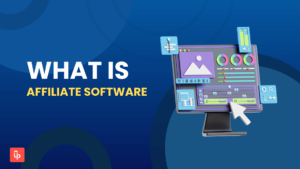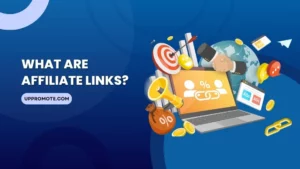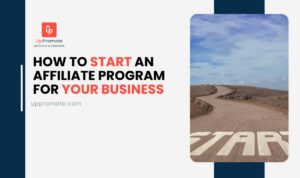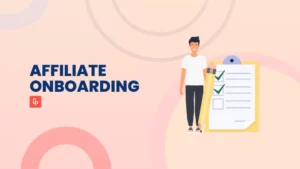Ever bought something just because a friend told you to? Maybe it was a skincare product your friend swears by. Or a local café your co-worker couldn’t stop talking about.
You’re not alone. 92% of consumers trust recommendations from people they know more than ads (Nielsen). That kind of trust is priceless and powerful.
If you’re struggling to find affiliates, maybe you’re new to affiliate marketing and don’t know where to start. Or you’re trying to scale your program but running into roadblocks. Influencers want high fees. And not every affiliate truly connects with your brand.
So why not start with the people who already believe in you: your happy customers?
In this guide, we’ll walk you through what customer affiliate marketing is, why your business should transform satisfied customers into brand advocates, 6 tactics to make it happen, and 5 practical ways to keep them engaged for the long run.
Turning customers into affiliates is powerful. But to make it work, you need the right tools to track every referral, reward each customer fairly, and keep the entire process smooth.
If you are looking for a powerful and 3-in-1 solution to turn your happy customers into affiliate partners, try UpPromote. It’s the top-trusted Shopify affiliate solution for growth with a 4.9/5 rating and over 2,500 reviews, offering a complete suite for affiliate, influencer, and referral marketing to help you grow faster.
With an easy referral program setup, attractive rewards, and robust tracking, UpPromote is the perfect tool to grow your customer base.
What Is Customer Affiliate Marketing?
Customer affiliate marketing, also known as customer referral marketing, is the practice of turning your existing customers into partners who promote your products and earn rewards for every sale they refer.
Instead of relying only on influencers or traditional affiliates, this approach focuses on real users. These people already know your brand and genuinely enjoy your product. With a little incentive, many are more than happy to share it with friends, family, or followers.
In most cases, this takes the form of a customer referral program, where each customer receives a referral link or a personal discount code. Every click and sale is tracked, and rewards are issued based on actual performance.
In short, it’s a structured way to harness word-of-mouth. You let your happiest customers spread the word and thank them in return for helping your business grow.
Why Customers Make Great Affiliates
Modern consumers are drawn to what feels real. In a world flooded with ads and influencer promotions, people look for voices they can trust. That’s why personal recommendations from actual customers have become one of the most powerful marketing assets for any brand.
Customers don’t speak in scripted endorsements. They share based on experience, emotion, and genuine satisfaction. This authenticity carries weight. According to Impact, 86% of consumers say authenticity is a key factor when choosing which brands to support.
At the same time, customer-centric approaches are on the rise. Modern brands are no longer just selling to customers. They’re building communities around them: inviting them to participate, share, and grow together. Turning customers into affiliates fits naturally into this shift.
And the results speak for themselves:
- Referred customers spend 34% more per transaction than non-referred customers (DemandSage).
- Referral traffic converts 3 to 5 times better than traffic from other channels (DemandSage).
- Referred customers are more likely to return and typically generate 16–25% higher lifetime value (Wharton via Impact).
- They are 4 times more likely to try new products and 54% more likely to make repeat purchases (DemandSage).
- You only pay for actual results, which makes it a low-risk, high-impact acquisition strategy.
- Referrals naturally boost brand trust and awareness. Studies show that word-of-mouth influences 20–50% of purchase decisions (Impact).
- Many brands running referral strategies have reported up to 86% year-over-year revenue growth (DemandSage).
Customers bring both credibility and results. When given the right tools and incentives, they become one of the most efficient and authentic ways to grow your business.
Just look at the example of SilverCeuticals. They’re a wellness brand that creates silver-based health products, a niche that not everyone immediately understands. It’s not easy to market something new, especially when there are strict regulations on what you can and can’t say in advertising.
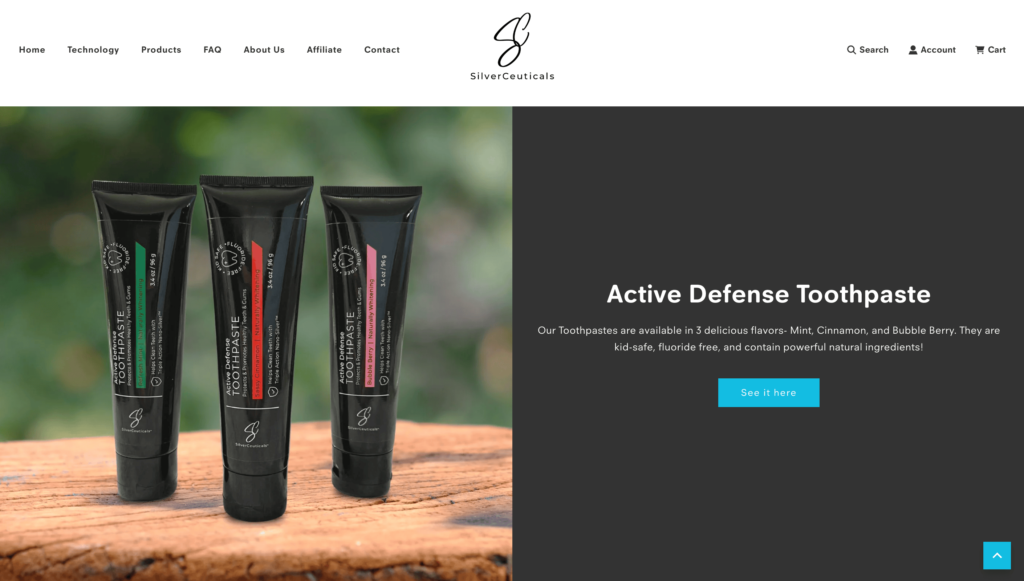
To overcome these challenges, they turned to their most powerful marketing asset: real product users. SilverCeuticals built a performance-based affiliate and referral program that invites customers and influencers to try the products and share their honest experiences. Using UpPromote, they streamlined the entire process, from sending out free samples to tracking referrals and rewarding affiliates with a generous 25% commission.
What happened? The results speak for themselves:
- They’ve built a network of over 1,100 active affiliates
- Affiliate and referral sales now account for 30% of their total revenue
The success of SilverCeuticals is proof that when customers are empowered with the right tools, support, and incentives, they can become your most trusted and impactful growth partners.
Ready to turn your customers into growth partners? Reward loyal fans with UpPromote’s referral program.
From Customers to Affiliates: 6 Conversion Tactics That Work
Finding the right affiliates is one of the biggest challenges for many brands. Traditionally, affiliates were publishers or influencers with large audiences. But today, that definition has expanded. Affiliates can be anyone, or even everyday customers.
This shift opens up new opportunities. Instead of chasing big names, you can activate one of the most trusted and scalable types of affiliates: your own customers.
Below are six practical ways to help you turn satisfied buyers into high-performing partners.
Identify the Right Customers
Before inviting customers to become your brand advocates, it’s important to choose the right people. Not every buyer is a good fit. Some purchase once and never come back. Others love your brand, keep engaging, and genuinely want to share it. These are the people you want to focus on.
So how do you spot them?
Look for customers who show consistent interest or positive sentiment toward your brand. A few clear signals include:
- Multiple purchases or high order frequency
- Positive reviews or high NPS (Net Promoter Score) feedback
- Social media mentions or tags
- Participation in loyalty programs or surveys
- High open or click-through rates in email campaigns
Start by reviewing customer data in your eCommerce platform. Most systems let you see order frequency, purchase value, product preferences, and how recently someone bought from you. This gives you a strong starting point to identify loyal or high-value buyers.
Use your CRM to build a fuller picture: tracking lifetime value, applying customer tags, or creating custom segments. You can also layer in insights from your email marketing tool, review app, and social listening platforms like Mention or Brand24 to find highly engaged customers.
Once you’ve identified this group, you can segment them and prepare a tailored outreach plan. The timing and method of that outreach are just as important, and we’ll explore that in the next section.
Nail the Timing
Identifying the right customers is only the first step. To turn them into affiliates, you also need to reach out at the right time.
Why does timing matter? Because even your most loyal customers won’t take action unless your invitation feels relevant and well-timed. If you ask too early, they might ignore it. Too late, and the excitement fades. The closer your message is to a positive brand moment, the higher your chances of turning interest into action.
These “conversion windows” often show up when a customer:
- Receive a product they love
- Leave a 5-star review or respond positively to an NPS survey
- Make their second or third purchase
- Share your product online
- Refer a friend naturally
So what should you do when these moments happen?
Here’s how to act on good timing:
1. Trigger a personalized invitation
Use your CRM, email automation tool, or affiliate software to set up trigger-based workflows. For example:
- After a 5-star review → send a “thanks + invite” email within 24 hours
- After order delivery → display an affiliate invite banner in their account or post-purchase email
- After second or third purchase → show a pop-up offer in their logged-in store experience
2. Keep the message relevant and light
Don’t oversell. Keep your tone friendly and natural. You could say something like:
“You’ve been such an amazing customer. We’d love to invite you to our affiliate program. You’ll earn rewards for spreading the word about something you already love.”
Mention their recent action to make the message feel personal and timely.
3. Show your offer in the right place
Add affiliate invitations in places that feel natural. For example:
- As a banner in the “Thank You” page after checkout
- In the order confirmation email
- Inside customer account dashboards (“Earn rewards by sharing us”)
These are moments when customers are still thinking about your brand, making it the ideal time to offer something more.
The bottom line: Nail the timing means knowing when a customer is emotionally and behaviorally ready, then making it easy and natural for them to say yes. When done right, this small shift can lead to much higher engagement and conversion.
Make Signup Effortless
Once you’ve identified the right customers and reached out at the right time, don’t let a complicated signup process get in the way.
Even your most loyal customers can lose interest if joining your affiliate program feels confusing or time-consuming. The more friction they face, the less likely they are to finish the process.
Here’s how to make signup smooth and inviting:
1. Keep the signup form short
Ask only for the essentials—name, email, and maybe their preferred payout method. Avoid long questionnaires or unnecessary fields. You can always collect more info later once they’re onboard.
2. Offer one-click access
If possible, allow customers to join directly from your store account or email with just one click. Many affiliate apps support auto-approval or pre-filled forms for existing customers, making the process feel effortless.
3. Explain what’s in it for them
Make your value proposition clear upfront. Whether it’s cash rewards, store credit, or exclusive perks, show them what they’ll gain and how easy it is to start.
4. Use friendly, brand-aligned language
Avoid technical terms like “affiliate tracking” or “conversion windows.” Instead, use phrases like “share and earn” or “get rewarded for spreading the word” that feel more natural to everyday customers.
When the signup process is clear, quick, and benefit-focused, your customers are far more likely to follow through.
To make this process even smoother, you can use affiliate software like UpPromote to run your customer referral program directly inside your store.
With UpPromote’s customer referral feature, you can turn buyers into affiliates without asking them to fill out long forms or go through a separate application process. The system is designed to meet your customers where they are, right in the flow of their shopping journey.
You can choose from 3 flexible ways to let customers join:
- Floating button: A small button on your store (often at the bottom corner) that lets visitors click and sign up at any time.
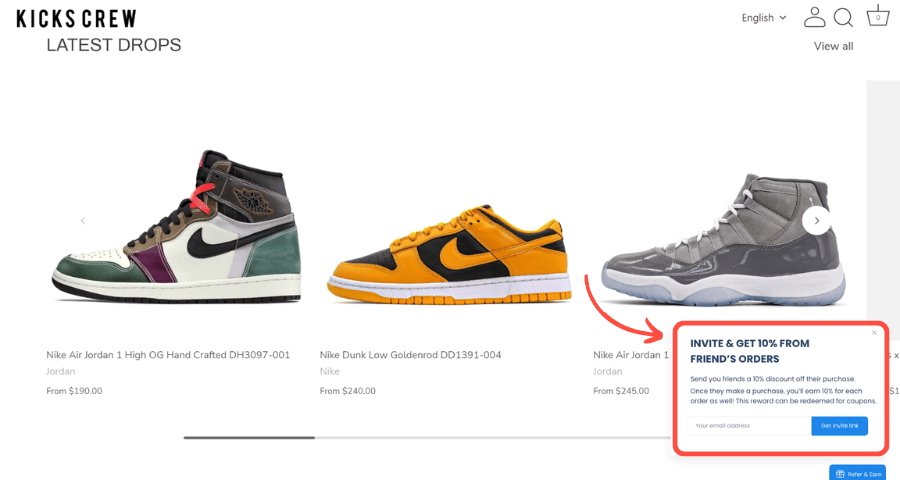
- Thank you page pop-up: After checkout, a pop-up invites the customer to refer friends and earn rewards, right when they’re feeling most satisfied.
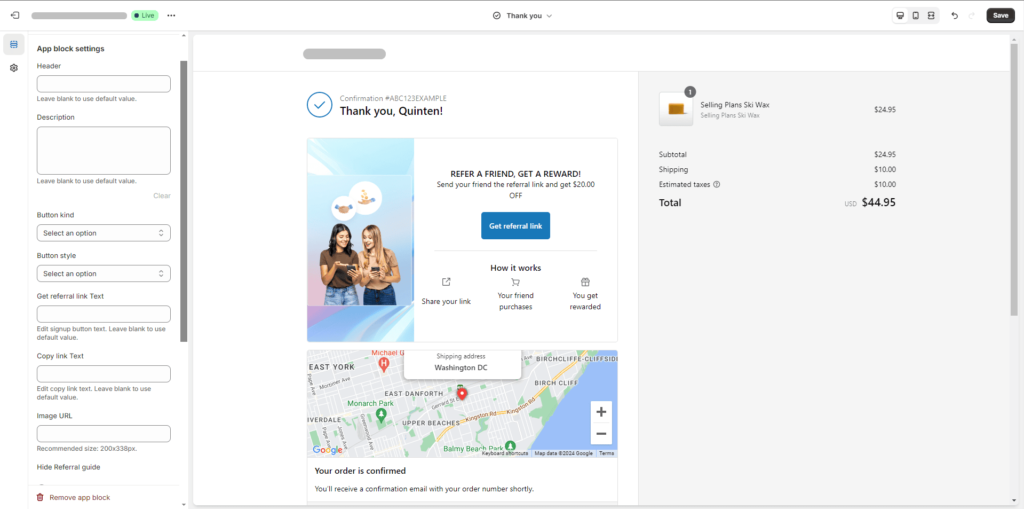
- Dedicated landing page: A fully branded “Share & Earn” page where customers can learn about the program and join anytime. You can link to this page from emails, menus, or your loyalty program.
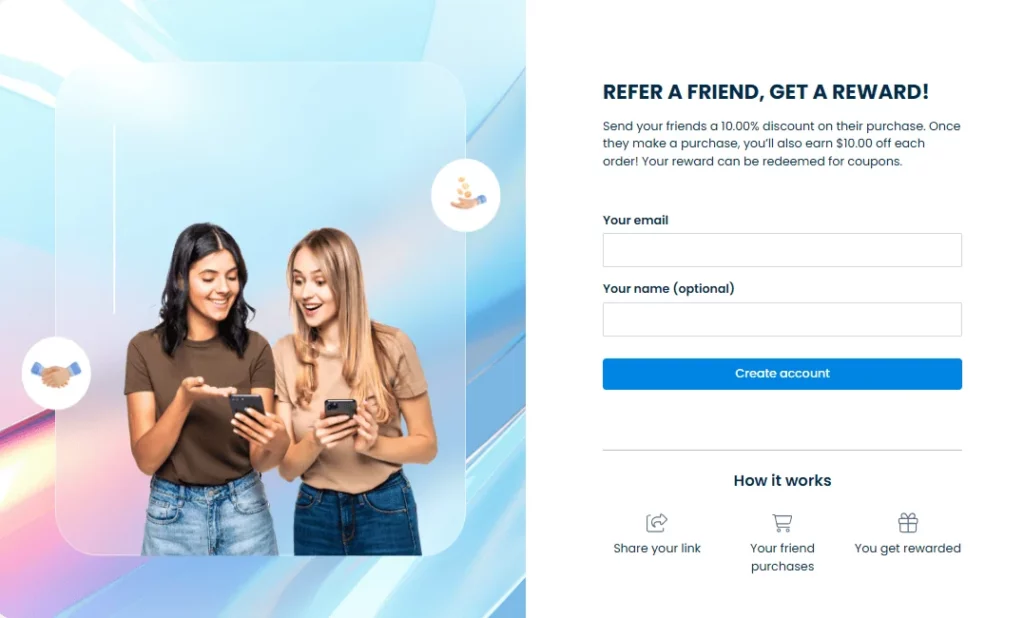
Once a customer joins, they instantly get their unique referral link or discount code. From there, everything is tracked automatically, clicks, referrals, conversions, and commissions. You don’t have to chase data manually or switch between platforms.
Leverage your customer base & turn delighted ones into affiliates right away.
Design Incentives That Motivate Action
You’re creating a program to invite customers to share your brand with others.
However, even if they love your product, it’s not fair to expect them to promote it for nothing. Sharing takes effort. And appreciation matters.
By offering something in return, you show that you value their support. More than that, you’re opening the door to a new kind of relationship where they’re not just fans, but official partners in your growth.
Here are 4 incentive ideas to make your offer feel rewarding and worth joining.
Attractive Commission Rates
Commission is often the first idea that comes to mind when thinking of how to reward customers for referrals and for good reason. It’s simple, direct, and effective.
Offering a commission creates a clear incentive for customers to join your program. Whether it’s a flat reward for each successful referral or a percentage of the sale, it gives them something concrete to look forward to. And when the reward feels fair, customers are more likely to take action.
There’s no one-size-fits-all number, but you can consider these factors to find your sweet spot:
- Average order value (AOV): How much does a customer usually spend?
- Gross margin: How much profit do you make per order?
- Customer acquisition cost (CAC): How much do you currently spend to get a new customer through ads or influencers?
A good starting point is to offer a reward that’s lower than your CAC but still feels meaningful to your customers. For example, if it normally costs you $40 to acquire a new customer, giving a $15 flat reward or 10% commission per successful referral can still keep you profitable while giving customers a real reason to participate.
Some big brands already offer attractive referral commissions. For instance, T-Mobile gives customers a $100 virtual prepaid Mastercard for each successful referral. Participants can earn up to $500 per year simply by referring friends and family who switch to T-Mobile.

💡 Tip: Be transparent about how much customers will earn and when they’ll get paid. Clear terms build trust and trust leads to more referrals.
Use Double-Sided Incentives
Rewarding both your customer and the person they refer to, what’s known as a double‑sided incentive is surprisingly common and effective.
According to Impact, 78% of referral programs follow the double-sided model. Why? Because it works:
- They foster loyalty on both sides: New customers feel welcomed with a special deal, while existing customers feel appreciated for spreading the word.
- They encourage genuine word-of-mouth: When customers know their friends will benefit too, they’re more likely to share your brand without hesitation.
- They make your program more attractive: Equal rewards signal that you value both new and existing customers.
Luxury skincare brand Estée Lauder runs a great example of this.
For every friend referred, both the existing customer and their friend receive $15 off a purchase over $75. The friend gets the discount on their first order, and the referrer earns their reward after the purchase is completed. Even better, customers can keep earning $15 credits for every successful referral, creating a cycle of rewards and loyalty.
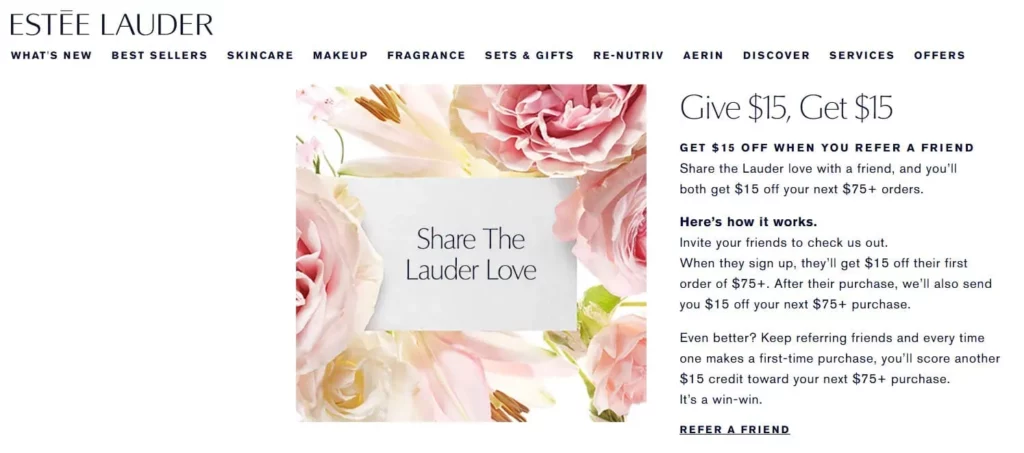
If your budget allows, setting up a double-sided offer is one of the smartest moves you can make. Here’s what you can think about when using double-sided incentives:
- Referrer reward: Offer a flat amount or percentage commission for each successful referral.
- Referred reward: Provide a discount, free shipping, or small gift to the friend who accepts the referral.
With UpPromote, setting up rewards for customers and incentives for their friends is easy. You can choose to reward customers with a flat amount per order or a percentage of each referred sale. At the same time, their friends can receive a discount in the form of a percentage, a fixed amount, or free shipping, depending on what fits your strategy best.
Gamify the Program
A little friendly competition can go a long way. Adding gamification to your customer referral program is a great way to keep customers engaged and motivated over time.
Instead of offering the same reward for every referral, try creating small challenges or milestones that make the experience feel more exciting. Think of it as turning your referral program into a game: simple, fun, and rewarding.
Here are a few ways to do it:
- Tiered rewards: Offer bigger incentives as customers hit certain referral milestones. For example, after their first referral, they get 10% off. After five referrals, they earn store credit or a free product.
- Leaderboards: Show top referrers each month to spark friendly competition. You can even spotlight them in your emails or social media to make them feel appreciated.
- Badges or achievements: Let customers unlock special badges or perks when they reach specific goals, like “Super Sharer” for referring ten friends.
- Limited-time referral events: Create time-based campaigns where customers can earn extra bonus for referring during a special window. This adds urgency and excitement.
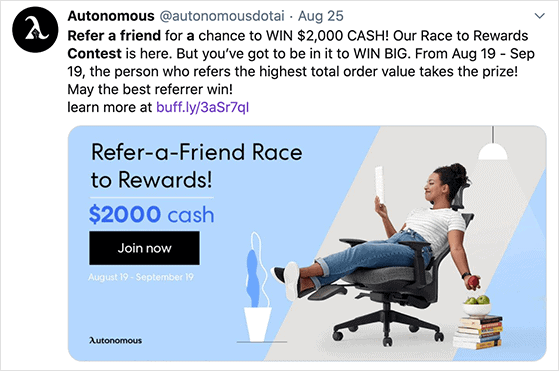
When done well, gamification doesn’t just boost referral numbers. It keeps your customers coming back, talking about your brand, and feeling like part of something fun and valuable.
Give Exclusive Gifts
Not every reward needs to be a discount or commission. Sometimes, a thoughtful gift can make someone feel even more appreciated. When a customer goes out of their way to share your brand, giving them something special in return shows that you truly value their support.
Offering exclusive gifts is a powerful way to make your referral program feel more special. These gifts don’t need to be fancy or expensive. What matters is that they feel personal, unique, or limited in some way.
Here are a few ideas:
- Early access to new products: Let loyal customers try upcoming items before anyone else. It makes them feel like insiders.
- Limited-edition items: Create small, referral-only items like a custom tote, sticker pack, or exclusive packaging. These feel special simply because they’re not available to everyone.
- Surprise add-ons: Include a handwritten thank-you card, a bonus sample, or a mystery gift in their next order. Even small surprises can create a moment of delight.
When you give customers something unique and thoughtful, you’re not just rewarding them. You’re creating a story they’ll want to share, and that’s what great referral marketing is all about.
Prime with Low-Friction Referrals
Customers don’t think like professional affiliates. They’re not actively looking for programs to join. But they do talk. And they do share especially when they’ve had a great experience with your brand.
Instead of asking them to become full affiliates right away, start by encouraging small, low-effort actions that get them used to promoting your brand naturally.
This is known as a “low-friction referral” approach. It’s based on a simple psychological principle called the “foot-in-the-door effect”. When someone agrees to a small action, they’re more likely to say yes to a bigger one later.
By planting this first seed, you lower their mental resistance. They don’t need to understand how an affiliate program works or fill out a sign-up form. All they need to do is share something they already enjoy.
Here are some easy ways to get them started:
- Ask them to share their recent order on Instagram Stories
- Invite them to tag a friend under a fun post on social media
- Run a mini game where sharing your brand earns entries
- Let them gift a discount code to a friend
These small steps lower the barrier. They help customers get comfortable with the idea of promoting your brand without even realizing they’re doing it. Over time, these customers become more open to joining your affiliate program when the opportunity feels natural and familiar.
Invite-Only VIP Loyalty Program
Your best customers aren’t just buyers—they’re brand fans. They come back often, leave glowing reviews, and talk about you without being asked.
Instead of inviting everyone to your affiliate program, why not create something more exclusive? An invite-only program for your top customers adds a sense of recognition and reward.
This isn’t your typical loyalty program with points and tiers. It blends two powerful models, loyalty and affiliate marketing, into one exclusive experience. You personally select the top customers based on real engagement, like ten or more purchases, high lifetime value, glowing reviews, or frequent social shares. Then, instead of a generic email blast, you send them a thoughtful, personalized invitation to join your private “VIP Club” or “Brand Ambassador Circle.”
Inside this invite-only program, they get access to:
- Higher commission rates than your regular referral program
- Exclusive discount codes to share with friends
- Early access to new product launches or limited drops
This approach keeps things focused and personal. You don’t need a big list, just the right people who already believe in what you offer.
5 Effective Ways to Help Customers Promote Better and Stay Engaged
Customers don’t always know how to promote, even when they love your brand. They’re not marketers.
That’s why it’s important to support them beyond signup. With the right tools, recognition, and timely nudges, you can turn casual promoters into long-term partners. These 5 strategies will help you do just that.
Onboard and Support Customer Affiliates Like Pros
Most customers don’t have experience with affiliate marketing. If you want them to promote your brand well, you need to give them a clear starting point, the right tools, and friendly guidance. A thoughtful onboarding process builds confidence, reduces confusion, and helps them start sharing right away.
Here are 3 practical ways to onboard and support them like a pro:
Personalized Welcome
Start with a warm, personalized welcome message. A generic email won’t do the trick. This is your chance to make them feel recognized and appreciated.
Let them know:
- What the program is about
- How they can earn rewards
- Why their support matters
Use their name, refer to their past purchases, and thank them for being part of your brand. A personal touch goes a long way in making them feel like part of something special.
Equip Them With Share-Ready Content
Don’t assume your customers know what to say or post. Make it easy for them by providing ready-made assets they can use right away. These might include:
- Product images and lifestyle photos
- Short, brand-aligned captions
- Their referral link or discount code
- Email and direct message templates to share with friends
You can consider creating a simple content hub or resource page where they can access these materials anytime. The easier you make it for them to promote, the quicker they’ll get started.
If using UpPromote, you can easily upload files and media (images, videos, docs, links) for your partners. Add categories to better organize your assets and help your customers access your resources faster and easier.
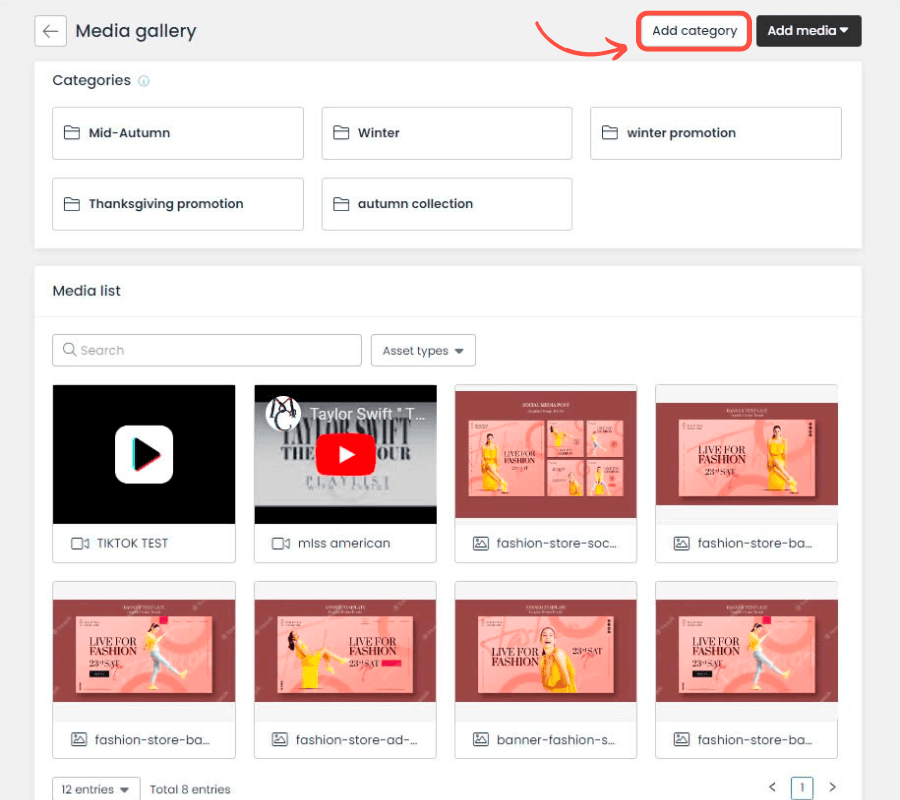
Don’t Skip the Training Step
Your customers aren’t affiliate marketers by trade. They might love your brand, but that doesn’t mean they automatically know how to promote it effectively.
That’s why a little training goes a long way.
You don’t need to build a full online course. But a few simple resources can make all the difference. The goal isn’t to overwhelm them. It’s to give them the confidence to share your brand the right way.
Here’s what to include:
- A quick overview of how your referral program works
- Step-by-step instructions on how to share their link or code
- Do’s and don’ts for promoting your brand
- Examples of real posts from other happy customers
- Answers to common questions (e.g., “When do I get paid?”, “Where can I track my rewards?”)
You can deliver this as a short video, a PDF guide, or even an onboarding email sequence. Keep it short, friendly, and actionable.
When customers understand how to participate and how to win, they’re more likely to stay engaged and promote with confidence.
Celebrate Success and Recognize Efforts
Customers don’t join referral programs just for the rewards. They also want to feel seen and appreciated.
A simple “thank you” can go a long way. And when you take the time to celebrate their impact, even in small ways, you turn everyday customers into proud brand advocates.
They’re not doing this as a job. They’re doing it because they love your brand. So when they hit a milestone, make sure they know it matters.
Here’s how you can recognize and motivate them:
- Send a personal thank-you email when they hit their first referral
Add a progress tracker in their customer dashboard so they can see how their efforts add up - Create a monthly shoutout in your newsletter or social media to spotlight top referrers
- Surprise them with a bonus gift when they reach a hidden milestone (e.g., 3rd referral or 5th friend joined)
With UpPromote, you can easily send surprise gifts to your satisfied customers after they join your program and bring great results. Simply turn on UpPromote’s gift feature to design and deliver custom reward packages that show your appreciation.
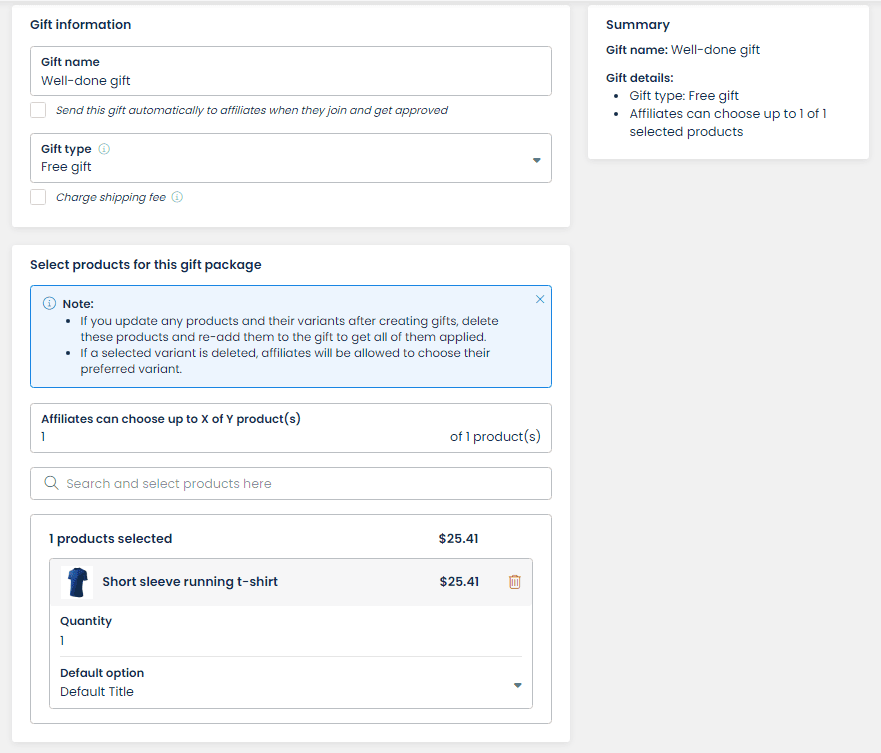
These small gestures create a sense of belonging and pride. They show your customers that their voice has value and that their support helps your business grow. And when customers feel valued, they’re more likely to stick around, share again, and bring others along with them.
Offer Co-Marketing Opportunities
Your customer affiliates don’t need millions of followers to help you grow. What they do have is authenticity and real influence within their circle. Co-marketing with them is a great way to make them feel valued and turn their voices into powerful promotional assets.
Here are some practical ways to co-market with your best customers:
- Share their stories on your official channels: Feature top customers in blog posts, newsletters, or social media updates. Highlight how they use your products or what they love about your brand.
- Invite them into branded content campaigns: Let them appear in lifestyle photos, testimonial videos, or “customer pick of the month” posts. It adds a real voice and face to your marketing.
- Conduct short interviews or user spotlights: Publish simple Q&As or video chats that give your audience a closer look at your customer advocates and their journey with your brand.
These kinds of collaborations deepen engagement and show your customers they’re not just referrers, but part of the story. When they feel seen and appreciated, they’re far more likely to stay active, loyal, and excited to promote your brand.
A great example of this approach in action is Glossier. The beauty brand didn’t just market to their customers. They made them the face of the brand. By consistently reposting customer selfies, everyday makeup routines, and real testimonials, Glossier created a powerful loop of community-driven marketing. Their hashtags like #GlossierPink and #GlossierGirl turned into movements, encouraging more customers to share and be part of the brand’s visual identity.
This user-first strategy helped Glossier build not just awareness, but deep brand love. And it all started by giving customers a voice and space in the brand’s story.

Build a Sense of Belonging
One powerful way to keep customer affiliates engaged and motivated is to make them feel like they’re part of something. Not just a one-time transaction. Not just a referral code. But a true community.
When customers feel included and connected to your brand’s mission, they’re more likely to keep promoting with genuine enthusiasm. Emotional loyalty leads to more consistent activity and stronger advocacy.
Here’s how you can build that sense of belonging:
- Give them a shared identity: Create a name for your advocate community such as “Insider Crew” or “Ambassador Circle.” A unique identity helps them feel like they’re part of a close-knit group.
- Create a space to connect: A private Facebook group, Slack channel, or email newsletter allows them to engage, ask questions, and celebrate wins with others who share the same excitement.
- Keep them in the know: Share behind-the-scenes updates, sneak peeks of new launches, or early access to sales. When they feel like insiders, their connection to your brand grows stronger.
- Invite their input: Ask for feedback, product ideas, or testimonials. When customers feel that their voice matters, they feel more invested in your success.
By building this kind of emotional connection, you’re not just gaining affiliates. You’re creating advocates who believe in your brand and want to be a part of its growth.
Track and Optimize Together
If you want your customer referral program to grow, you can’t just set it and forget it. Tracking performance and making small improvements over time is key. It’s not just for your business, but for the people helping to promote it too.
When customers see their impact, they feel more motivated. When you know what’s working, you can help them do even better.
To build that momentum together, try a few of these ideas:
- Share simple performance updates: Let customers know how many clicks or sales they’ve generated, how close they are to a reward, or how much their referrals have saved others. Even a short email with these highlights can go a long way.
- Set friendly goals: Create fun milestones like “3 referrals this month” or “first successful sale” and offer small bonuses to hit them. It keeps things playful and engaging.
- Highlight top performers: Shout out active participants in your emails or on social media. Recognition builds confidence and encourages others to join in.
To make this process easier and more accurate, using affiliate software that provides detailed reports and analytics is a smart move.
If you’re using UpPromote, you get a clear view of how your referral program is performing. The dashboard shows detailed reports on key metrics like the number of customer affiliates, referral orders, commissions earned, and top-performing traffic sources. Everything is organized into easy-to-read charts and tables. With these insights, you can refine your strategies to optimize your program.

FAQs
1. What’s the difference between customer affiliate and referral?
They’re very similar, and in many cases, they overlap.
A referral usually means your customer shares your brand with a friend and gets a reward when that friend buys.
A customer affiliate is a bit more structured. They might get a special link or code to share, and you can track their results like a regular affiliate.
2. What’s the best way to ask a customer to become an affiliate?
Keep it personal and simple. Reach out after a happy moment, like after a good review or a second purchase and invite them to share what they already love.
A friendly message like “Want to get rewarded for sharing us with your friends?” can work well.
3. Do I need to offer cash rewards?
Not always. Cash is great, but store credit, discounts, free gifts, or early access to new products can work just as well. The key is offering something your customers actually care about.
4. How do I track customer affiliate sales?
Use affiliate software that gives each customer a unique link or discount code. Every time someone buys through their link or uses their code, the system tracks it for you automatically.
5. Can I run both affiliate and referral programs together?
Yes, and many brands do. You can have a public affiliate program for creators and influencers, and a customer referral program just for happy customers. Just make sure each group has a clear path and reward system.
6. What tools can I use to manage customer affiliates?
You can use affiliate and referral apps to do just that. These tools let you create referral links or discount codes, track performance, and reward your customers automatically. They also help keep everything organized so you don’t have to manage it all manually.
A good example is UpPromote, a 3-in-1 solution for affiliate marketing, influencer marketing, and customer referrals. The app gives you everything you need in one place to run your programs and manage your partners.
Final Words
Customer affiliate marketing isn’t just a trend. It’s a smart, scalable way to grow your business with the people who already love what you do. By turning satisfied customers into active promoters through a well-structured customer referral program, you build a community of partners rooted in trust and genuine connection.
By identifying the right customers, reaching out at the right time, offering thoughtful incentives, and keeping them engaged, you create a system where everyone wins. Customers feel appreciated and rewarded. Your brand reaches more people. And your growth becomes more sustainable.
But managing it all manually can be time-consuming and messy. That’s where using an affiliate and referral app can make a real difference. It helps you automate tracking, streamline communication, and reward your customers with ease. With the right tools, like UpPromote, you’ll be able to run your program smoothly while giving your customers the recognition and benefits they deserve.
In the end, it’s about more than just growing sales. It’s about building long-term relationships with people who already believe in your brand and giving them the opportunity to help it thrive



